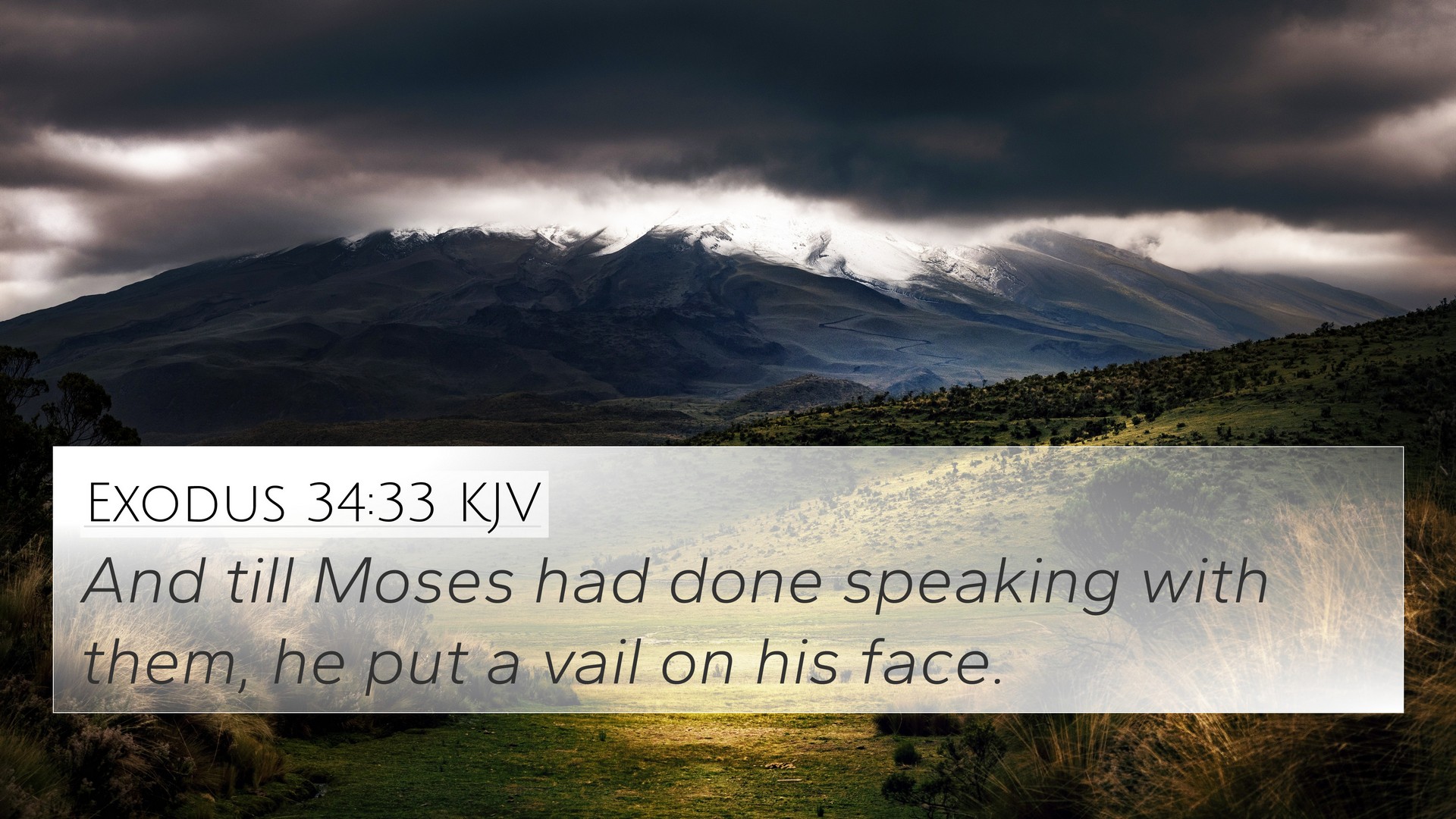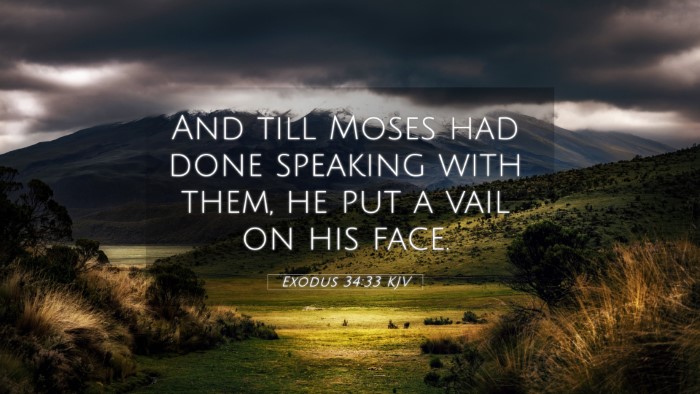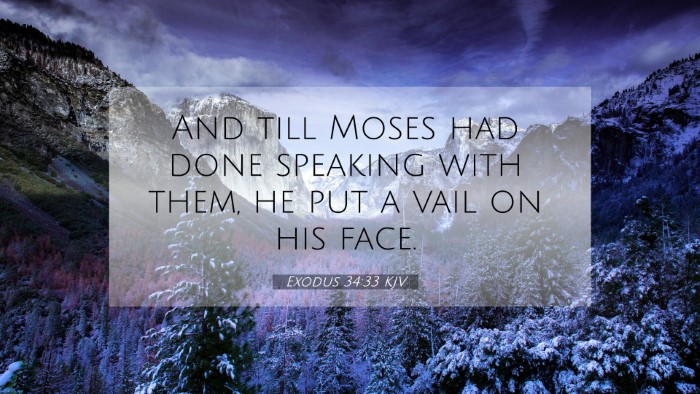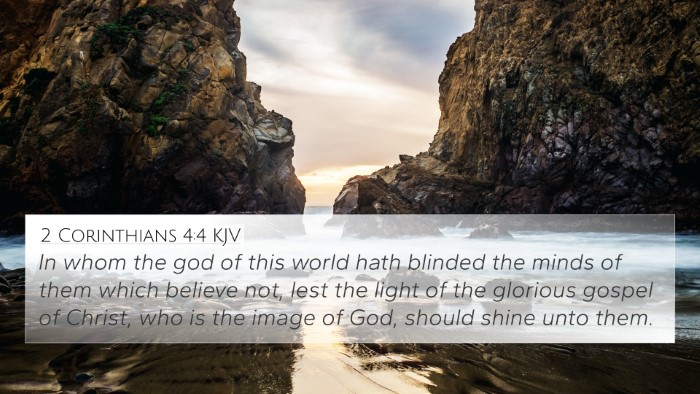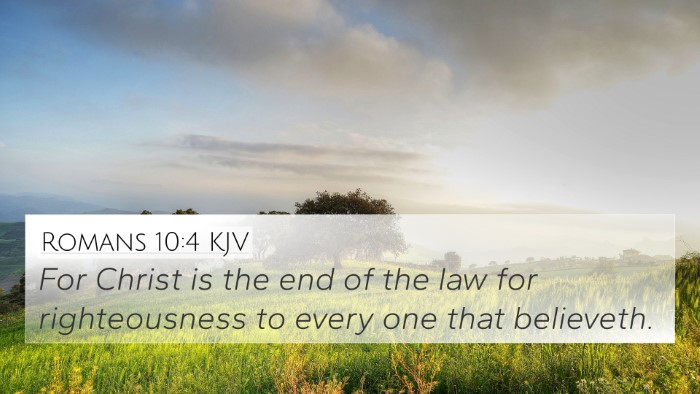Understanding Exodus 34:33
Exodus 34:33 states, "And till Moses had done speaking with them, he put a veil on his face." This verse is rich with implications regarding Moses' encounters with God and the transformative nature of divine encounters. Here, we explore the meaning of this verse through insights from renowned public domain commentaries.
Overview of the Context
In the broader context of Exodus 34, Moses has just received the Ten Commandments and has been in the presence of the Lord. The glory of God had so impacted him that his face shone brightly, revealing the divine light bestowed upon him. To maintain a level of separation between himself and the people, Moses chose to veil his face.
Commentary Insights
- Matthew Henry: Henry explains that Moses’ veiling of his face served both a practical and symbolic purpose. It prevented the Israelites from being overwhelmed by the radiant glory of God reflected in Moses. The veil also symbolizes the idea that the fullness of God’s glory could not be directly approached by humanity due to sinful nature.
- Albert Barnes: Barnes emphasizes how this act of veiling signified a distance between God and man. Although Moses had seen the glory of God, the glory was not entirely accessible to the Israelites, suggesting an ongoing need for mediation in their relationship with God.
- Adam Clarke: According to Clarke, the specifically stated reason for the veil was to prevent the Israelites from seeing the glory diminishing over time. This signifies not only the transient nature of such divine experiences but also mankind's inability to continually bear God’s unfiltered presence.
Spiritual Significance
This verse holds significant spiritual implications, reflecting on themes of divine glory, human limitation, and the need for intercession. The veil serves as a powerful metaphor for the separation between a holy God and a sinful people.
Cross-References
Exodus 34:33 connects with several other scriptures, enriching our understanding of its themes:
- 2 Corinthians 3:13-16: Paul reflects on Moses' veil, illustrating how it represents the Jewish understanding of the law, which is veiled to them due to their unbelief.
- Hebrews 10:19-20: This passage speaks to the access believers have to God through Christ, contrasting the veiling in the Old Testament with the unveiled approach brought by the New Covenant.
- Exodus 34:29: Earlier in the chapter, it establishes that Moses' face shone after talking with God, leading to the context of the need for a veil.
- Matthew 17:2: During the Transfiguration of Jesus, His face shone like the sun, signifying the continuity of divine glory in the New Testament.
- John 1:14: Emphasizes the incarnation of Christ as the manifestation of divine glory, showing the ultimate revelation of God's nature.
- 1 John 3:2: Speaks to the future hope of seeing God without any veils, as believers will be made like Him fully in glory.
- Romans 3:23: Points to the universal condition of sin that necessitates the separation represented by the veil.
- Isaiah 59:2: Illustrates how sins create a barrier between God and humanity, akin to the veiling of Moses' face.
Thematic Bible Verse Connections
The themes of glory, mediation, and the relationship between God's holiness and human sinfulness continue throughout scripture:
- Leviticus 16:2: Discusses the need for mediation and the fear of approaching God improperly.
- Galatians 3:24: Describes the law as a tutor leading to Christ, echoing the mediatorial role of Moses.
- Revelation 21:23: Presenting a time when God’s glory will no longer be veiled, emphasizing the fulfillment of divine promise in the end times.
Conclusion
Exodus 34:33 serves as a poignant reminder of the necessity for divine mediation and speaks to the incredible transformation that comes with being in God's presence. The insights from various commentaries together with the cross-references highlight an essential truth: humanity's relationship with God is characterized by both awe and distance, pointing to the need for Jesus Christ's ultimate sacrifice that bridges that gap.
